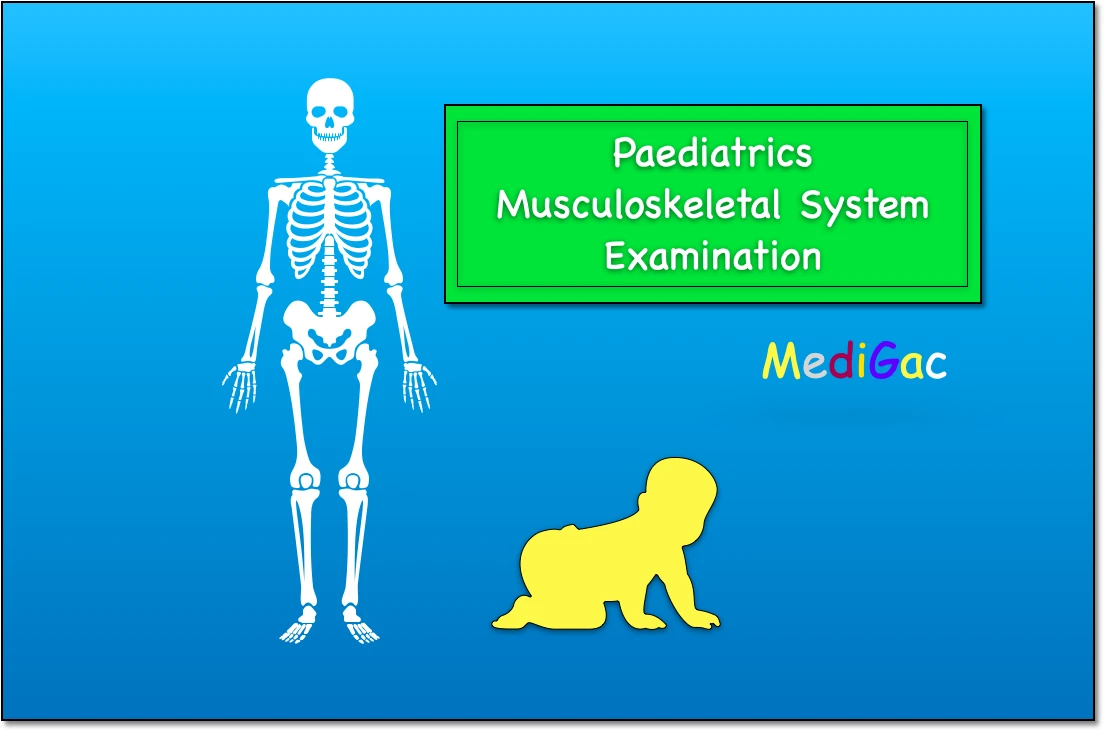
How to do Paediatrics examination of muscle and skeletal system. We have discussed this section in three parts and they are :
A. How to do the General examinations :
At first the patient is asked, for any pain/stiffness of muscle joint, bone, arthritis history if present, walking up and downstairs, dressing ability etc.
- GALS( gait, arms, legs and spine) – For musculoskeletal or neurological deficits, the GALS screen provides a quick and sensitive approach.
- Abnormal gaits – A limp is a gait that is aberrant owing to discomfort or anatomical changes. Lower limb length disparity, tone abnormalities, or weakness are examples.
- Any deformity, protrusion, soft tissue swelling, or lymph node enlargement are all looked for by the examiner.
B. How to examine the Upper limbic system :
I. General examination of upper limb :
- Hand – We look for clubbing, edoema, cyanosis, koilonychia, palmar erythema, Dupytren’s contracture, Synovitis, Thenar or hypothenar wasting, Dupytrenes contracture, and other common symptoms. Any type of neck deformity, such as swan neck, buttonaire, muscle atrophy, MCP and IP joint enlargement, Onycholysis, and Cripitus.
- Neurological examination – Muscle tone, muscle bulk, muscle reflexes (Biceps, Triceps, Branchioradial), and muscle group power or strength are all tested here.
- Pulse and BP – The pulses of the radial and brachial arteries are measured.
II. Locomotor examination of upper limb :
1. Shoulder examination :
- Inspection – Any deformity, waste, or edoema is looked for here.
- Palpation – Joints, bones, and joint tenderness are all palpated.
- In shoulder movement we check for Flexion, Extension, Abduction, Adduction, Lateral rotation, Medial rotation.
2. Elbow examination
- Inspection – On the proximal extensor surface of the forearm, we look for swelling, bruising, scarring, rash, olecranon process, gout, nodule of osteoarthritis, and JIA.
- Palpation – Sponginess, bony shapes Tenderness in certain areas, such as the lateral epicondyle of Tennis elbow and the medial epicondyle of Golfer’s elbow, Rheumatoid nodules on the proximal extensor surface of the forearm are known as bursae.
- In movements we check for Flexion and Extension.
3. Wrist examination :
Inspection, palpation, and movement are the key areas of attention for us.
- The patient is requested to raise their arms outwards and up above their heads; typical elevation is 180 degrees.
- Prayer sign/reverse prayer sign is seen
- In movements we check for Dorsiflexion(extension). Palmar flexion, Ulnar deviation and Radial deviation.
C. How to examine the Lower limbic system :
1. Spine examination :
A.Inspection or looking :
- Leg symmetry, as well as muscle bulk and trunk, are examined.
- A tuft of hair, a gibbus, a dimple, a meningocoele, a meningomylocoele, a sacrococcygeal teratoma, and a meningocoele are all visible.
- Any deformity, protrusion, soft tissue swelling, or lymph node must be checked.
- Next, we must look for any asymmetry at the iliac crests; if any asymmetry is discovered, it is pathological.
- The gluteal, hamstring, popliteal, and calf muscles show any edoema or other abnormality.
- Next, look for edoema and deformity in the Achilles tendon and hindfoot.
B. Percussion :
- If there is any soreness in the spinal or paraspinal tissues.
- The examiner then lightly taps the spine with a closed hand or finger, noting any soreness.
- The presence of any spinal defect is felt.
- Any enlargement observed, such as meningocoele or gibbus, should be palpated.
- The patient’s thoracolumbar rotation is assessed by having him or her grip the pelvis and turn side to side without moving their feet.
- The patient is then instructed to glide his hand along the lateral portion of his leg toward his knee. Lateral lumbar lordosis is the medical term for this condition.
C. Movements :
- Movements checking – Here we will check for Flexion, Extension and Lateral flexion.
2. Hip joint examination :
A. Look-Inspection :
- Examine the gait
- Is the stance straight?
- Muscle degeneration
- Scoliosis or straight spine
- Disfigurement
- Gluteal atrophy is a condition in which the muscles of the gluteus maximus.
- Scars, sinuses, dressings, or any other modifications to the skin.
B. Feel-Palpation :
- Trochanteric bursitis causes tenderness over the greater trochanter.
- In sports injuries, tenderness around the lesser trochanter and ischial tuberosity owing to iliopsoas and hamstring starins, respectively.
C. Movements :
- Movements examination – We will check for abduction,adduction, Flexion and External rotation.
3. Knee joint examination :
A. Look-Inspection :
- Scars\Sinuses
- Valgum genu
- Varum genu
- Muscle atrophy
- Disparity in leg length
- Flexion deformity is a type of malformation that occurs when a
- Swelling\Erythema\Rashes
- Baker’s cyst
- Varicose Vein Deformity with Fasciculation
B. Feel-Palpation :
- Inflammation and swellings
- Both sides’ warmth
- Effusion, which can be detected with a patellar tap and a bulging test.
C. Movements :
- Movements examination – We will check for extension and flexion
4. Foot examination :
A. Look-Inspection :
Wasting, any deformity is seen. Deformity like claw toes and hemmer toes are observed.
B. Feel-Palpation :
A synovitis of the metatarsophalangeal joint is a day light symptom identified in JIA.
C. Movements :
- Movements checking – Dorsiflexion, Plantar flexion, Inversion and eversion is seen.